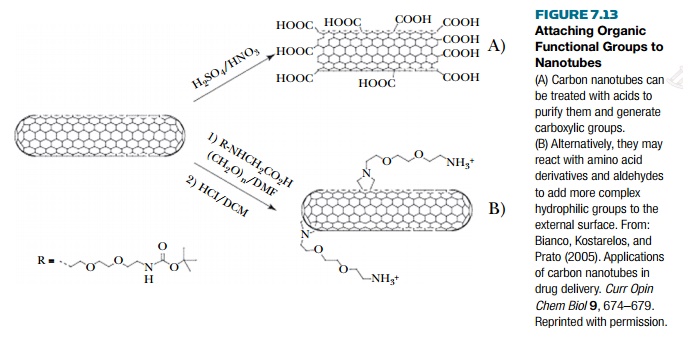Chapter: Biotechnology Applying the Genetic Revolution: Nanobiotechnology
Nanotubes
NANOTUBES
Carbon nanotubes are cylinders made of pure carbon with diameters of 1 to
50 nanometers. However, they may be up to approximately 10 micrometers long.
Pure elemental carbon exists as diamond or graphite. In diamond, each carbon is
covalently linked to four others forming a 3-D tetrahedral lattice that is
extremely strong. In contrast, graphite consists of flat sheets of carbon atoms
that form a hexagonal pattern. In the sheets of graphite, each carbon atom is
covalently bonded to three neighbors and the sheets can slide sideways over
each other, because there are no covalent linkages between atoms in different
sheets.
To form a nanotube, a single
sheet of graphite is rolled into a cylinder. The sheets may be rolled up
straight or at an angle to the carbon lattice and may be of various diameters.
Depending on the diameter and
the torsion, the nanotube may act as a metallic conductor or a semiconductor.
Not surprisingly, nanotubes are now finding many uses in electronics, a topic
beyond the scope of this book.
In biotechnology, nanotubes
are just beginning to find applications. The critical issue is attaching other
biomolecules, such as enzymes, hormone receptors, or antibodies, to the
nanotube surface. One idea is to build biosensors where interaction of, say, an
antibody with its target antigen will change the electrical behavior of the
nanotube. Hence it should become possible to generate an electrical signal on
detecting hormones, pathogens, pollutants, and so forth.

A major problem in attaching
proteins is that the surface of carbon nanotubes is hydrophobic. One way to
attach biomolecules is to first modify the surface by adding nonionic
detergents, such as Triton X100. The hydrophobic portion of the detergent binds
to the nanotube surface and the hydrophilic region can be used for binding of
proteins. Alternatively, chemical reagents may be used that react with the
carbon surface of the nanotube and generate side chains carrying reactive
functional groups. Proteins can then be linked covalently by reaction with
these (Fig. 7.13). Creation of devices by combining biological molecules with
nanotubes is still in its infancy, but progress in this area is likely to be
rapid.
Related Topics